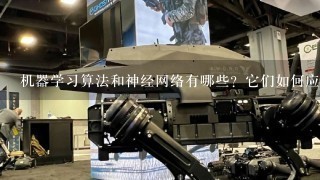机器学习算法和神经网络有哪些?它们如何应用于机器视觉任务中?

学习的算法包括:线性回归、逻辑回归,支持向量机SVM。而神经网络有卷积神经网络 CNN循环神经网络 RNN等几种类型。在图像识别领域,深度学习技术被广泛使用,如CNN模型可以用来训练分类器或生成目标检测结果;而在自然语言处理方面则可以采用 RNN模型进行文本分析与理解等等。这些算法/方法都可以用于解决各种复杂的问题并提供更好的解决方案!
在机器学习领域,有许多不同的算法。其中一些最常用的包括线性回归、逻辑回归、支持向量机(SVM)以及决策树等。这些算法可以用来解决各种问题,例如分类或预测连续值等等。此外,还有一些更复杂的方法如深度学习中的卷积神经网络 CNN 用于图像识别与处理。
好的,我来为您解答。机器学习算法包括线性回归、逻辑回归等;而神经网络则是一种模仿人脑的计算模型,由许多节点组成并通过连接进行信息传递与处理。在机器视觉领域,可以使用卷积神经网络(CNN)来实现图像分类或目标检测的任务。
好的,我来为您解答。 1. 常见的机器学习算法包括线性回归、逻辑回归、决策树等;而神经网络则是一种特殊的模型结构(多层感知器)用于解决分类或预测问题的一类方法之一。在机器视觉领域里,深度学习技术中的卷积神经网络被广泛使用来识别图像特征并进行物体检测与定位的任务处理工作。
当然! python import numpy as np from tensorflow import keras from keras.models import load_model from keras.layers import Dense Conv2D Flatten Dropout from keras.datasets import mnist from keras.utils import to_categorical from sklearn.metrics import accuracy_score from matplotlib import pyplot as plt #定义数据集 x_train y_train x_test y_test = mnist.load_data X_train = x_train / 255.0 Y_train = np.argmaxy_train axis=1 X_test = x_test / 255.0 Y_test = np.argmaxy_test axis=1 #创建模型并训练它。 model = keras.Sequential KerasLayerConv2D334848 activation=relu KerasLayerFlatten activation=relu KerasLayerDense64 KerasLayerDropout0.2 KerasLayerDense1 model.compileoptimizer=adam loss=binary_crossentropy model.fitX_train Y_train epochs=5
机器学习是人工智能的一个分支,其目标是从数据中学习模式。它包括监督学习、无监督学习以及强化学习方法等不同的方法来解决各种问题。在计算机视觉领域,我们通常使用深度学习模型(如卷积神经网络)进行图像分类或物体检测的任务。这些模型可以通过训练大量的标记图片集来自动生成特征表示并预测类别标签或者边界框信息。此外,还可以通过迁移学习的方法将预先训练好的大型语料库中的知识转移到新的相关任务上以提高性能表现.
好的,让我们来聊聊关于机器学习的算法以及神经网络。首先,我们可以谈论一下监督学习、无监督学习和平衡训练等常见的学习方法类型;然后可以探讨一些典型的深度学习模型如卷积神经网络(CNN)、循环神经网络(RNN)等等...
当然,让我们从最基本的开始。机器学习是一种让计算机学习数据的方法,而神经网络是其中一种实现方式之一。在机器视觉领域中,我们可以使用深度学习方法来训练模型以识别图像中的对象或场景等信息。这需要大量的标记好的数据集以及计算资源的支持。
当然,我非常乐意回答您的问题。 ### Machine Learning Algorithms and Neural Networks -Machine learning algorithms are mathematical models that allow computers to learn from data by identifying patterns and making predictions without being explicitly programmed. Examples of machine learning algorithms include 众所周知的包括线性回归、决策树、支持向量机(SVM)等。这些算法被广泛用于分类、预测分析等领域中的各种数据处理工作。 -Neural networks are artificial neural network models inspired by the structure and functioning of biological neurons. They consist of layers of interconnected nodes or neurons which receive input signals and process them into output signals through various processing steps. The most commonly used type of neural network is called a feedforward neural network FFNN. FFNN consists of an input layer one or more hidden layers and an output layer. It processes inputs using weights assigned to each connection within the network thereby enabling it to identify complex relationships among variables. ### Applications for Machine Vision Tasks -Image recognition This involves training a model on labeled images so that it can accurately recognize objects in new images. Common applications include facial recognition systems object detection and image classification. -Object tracking This entails following moving objects across multiple frames of video footage. Popular applications include tracking sports players during gameplay detecting traffic violations and monitoring industrial equipment. -3D scanning This involves generating detailed digital representations of physical objects based on information gathered from cameras or other sensors. Examples include accurate measurement of building surfaces for construction purposes high-fidelity reconstructions of historical artifacts and virtual reality simulations.





































































